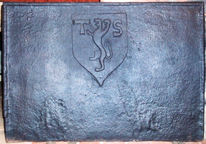-
921
Description: Canted rectangle; twisted rope edging (top and sides); central arrow-shaped design formed of three repeated rope lengths.
Notes: The arrow design probably has an apotropaic (evil-averting) purpose, perhaps intended as the initials VV for 'virgo virginum'.
- Decoration tags:
- rectangular with canted top corners (shape)
- rope (edging)
- simple stamps
- apotropaic
- objects
Manufactured: in the 16th century in the Weald area of England.
Current location: in private hands, Heathfield, East Sussex, England.
- Attached to series:
- Rope design firebacks
-
383
Description: Arched rectangular shape; thin twisted rope edging on top and sides; trailing vine strips frame a row of repeated bird (probably swan) stamps (5) above repeated rose en soleil stamps (5); single bird stamp with two short, slanting vine strips in top arch.
Notes: The rose-en-soleil was the badge of King Edward IV and, thus, a Yorkist symbol, while the swan had been adopted by Henry IV and was, therefore, a Lancastrian symbol.
- Decoration tags:
- rectangular with round arch (shape)
- rope (edging)
- simple stamps
- carved stamps
- heraldic
- objects
Manufactured: in the mid- to late-16th century possibly at Pounsley Furnace, Framfield in the Weald area of England.
Current location: Anne of Cleves House, Southover High Street, Lewes, East Sussex, England.
Museum number: LH000.941 (part of the Sussex Archaeological Society museum group)
Citation: Butterfield, W. R., 1916, 'Old Wealden Firebacks', The Connoisseur, 46, pp. 197-209.
-
859
Description: Rectangular; twisted rope edging (to and sides); top centre, shield bearing a lion rampant with two heads, between split initials.
Notes: The heraldic charge of a lion rampant with two heads is rare, the only documented family with which it is associated being that of Mason, of Yorkshire, to whom this shield does not seem to apply.
Inscription: TS
Arms: Not known
- Decoration tags:
- rectangular (shape)
- rope (edging)
- carved stamps
- heraldic
- armorial
- text
Manufactured: in the early-16th century in England.
Current location: not known.
- Attached to series:
- Personal armorial firebacks


